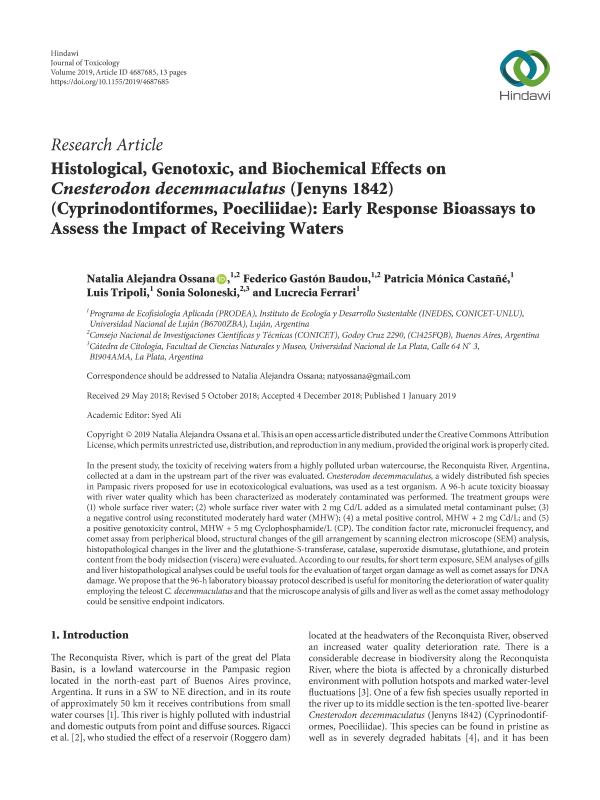Artículo
Histological, genotoxic, and biochemical effects on Cnesterodon decemmaculatus (Jenyns 1842) (Cyprinodontiformes, Poeciliidade): early response bioassays to assess the impact of receiving waters
Ossana, Natalia Alejandra ; Baudou, Federico Gastón
; Baudou, Federico Gastón ; Castañé, Patricia M.; Tripoli, Luis; Soloneski, Sonia Maria Elsa
; Castañé, Patricia M.; Tripoli, Luis; Soloneski, Sonia Maria Elsa ; Ferrari, Lucrecia
; Ferrari, Lucrecia
 ; Baudou, Federico Gastón
; Baudou, Federico Gastón ; Castañé, Patricia M.; Tripoli, Luis; Soloneski, Sonia Maria Elsa
; Castañé, Patricia M.; Tripoli, Luis; Soloneski, Sonia Maria Elsa ; Ferrari, Lucrecia
; Ferrari, Lucrecia
Fecha de publicación:
01/2019
Editorial:
Hindawi Publishing Corporation
Revista:
Journal of Toxicology
ISSN:
1687-8191
e-ISSN:
1687-8205
Idioma:
Inglés
Tipo de recurso:
Artículo publicado
Clasificación temática:
Resumen
In the present study, the toxicity of receiving waters from a highly polluted urban watercourse, the Reconquista River, Argentina, collected at a dam in the upstream part of the river was evaluated. Cnesterodon decemmaculatus, a widely distributed fish species in Pampasic rivers proposed for use in ecotoxicological evaluations, was used as a test organism. A 96-h acute toxicity bioassay with river water quality which has been characterized as moderately contaminated was performed. The treatment groups were (1) whole surface river water; (2) whole surface river water with 2 mg Cd/L added as a simulated metal contaminant pulse; (3) a negative control using reconstituted moderately hard water (MHW); (4) a metal positive control, MHW + 2 mg Cd/L; and (5) a positive genotoxicity control, MHW + 5 mg Cyclophosphamide/L (CP). The condition factor rate, micronuclei frequency, and comet assay from peripherical blood, structural changes of the gill arrangement by scanning electron microscope (SEM) analysis, histopathological changes in the liver and the glutathione-S-transferase, catalase, superoxide dismutase, glutathione, and protein content from the body midsection (viscera) were evaluated. According to our results, for short term exposure, SEM analyses of gills and liver histopathological analyses could be useful tools for the evaluation of target organ damage as well as comet assays for DNA damage. We propose that the 96-h laboratory bioassay protocol described is useful for monitoring the deterioration of water quality employing the teleost C. decemmaculatus and that the microscope analysis of gills and liver as well as the comet assay methodology could be sensitive endpoint indicators.
Archivos asociados
Licencia
Identificadores
Colecciones
Articulos(INEDES)
Articulos de INSTITUTO DE ECOLOGIA Y DESARROLLO SUSTENTABLE
Articulos de INSTITUTO DE ECOLOGIA Y DESARROLLO SUSTENTABLE
Articulos(SEDE CENTRAL)
Articulos de SEDE CENTRAL
Articulos de SEDE CENTRAL
Citación
Ossana, Natalia Alejandra; Baudou, Federico Gastón; Castañé, Patricia M.; Tripoli, Luis; Soloneski, Sonia Maria Elsa; et al.; Histological, genotoxic, and biochemical effects on Cnesterodon decemmaculatus (Jenyns 1842) (Cyprinodontiformes, Poeciliidade): early response bioassays to assess the impact of receiving waters; Hindawi Publishing Corporation; Journal of Toxicology; 2019; 1-2019; 1-14
Compartir
Altmétricas



